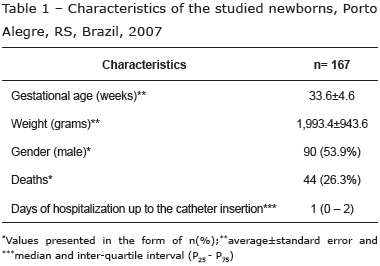This study identifies the adverse events related to the use of central venous catheters (CVC) in newborns admitted to a neonatal care unit. This is a quantitative, descriptive and retrospective study. The population consisted of 167 newborns admitted in the neonatal unit of the Hospital de Clínicas at Porto Alegre, RS, Brazil which used CVCs inserted through percutaneous puncture (PICC) and surgical insertion, totaling 241 catheters. There was a higher prevalence of mechanical adverse events in the PICC line insertions, with a preponderance of catheter occlusions (19.44%) and ruptures (8.8%). The surgically inserted CVCs had a higher prevalence of catheter-related infectious adverse events with the most common being clinical sepsis (16%). This study suggests that the correct insertion technique should be used and a specialized team should monitor the CVCs to ensure safety and prevent adverse events.
Infant; Newborn; Catheterization; Central Venous; Adverse Effects


